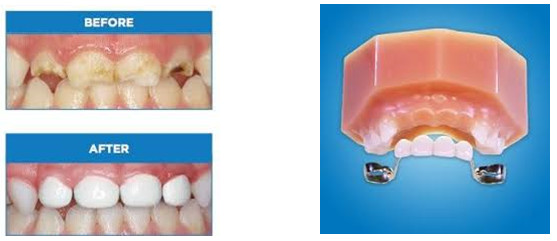At My First Dentist, we make sure to offer our patients the option of having pediatric partials. Tooth loss, or edentulism, isn’t a problem reserved only for older adults. Instead, it affects all age groups, young or old.
Whether as a result of trauma, playground accident, or dental decay, even toddlers and children may need a tooth or two extracted and replaced from time to time. In fact, tooth loss in early childhood is quite normal. For children between the ages of 2 to 8 still awaiting the emergence of their permanent teeth, traditional solutions, such as dental implants, are completely impractical and unnecessary. Instead, for young children, the path to new teeth are pediatric partials.
Parents of young children with missing teeth should consult with My First Dentist to see if pedi-partials are the right solution for their children.
What Are Pediatric Partials (or Pedi-Partials)?
Pediatric partials are the dentist-recommended solution for missing teeth in toddlers and young children between the ages of 2 to 8 years old. For kids, traditional solutions simply won’t do.
Instead, pediatric partials give dentists and parents a dental solution designed for a toddler’s mouth and only intended to temporarily replace a child’s deciduous teeth until their permanent teeth can fully erupt.

Pediatric partials, like adult partials, are custom-crafted prosthetic devices that replace missing teeth. Unlike their adult counterparts, pedo-partials are designed to be temporary.
Why choose Pediatric Partials (or Pedi-Partials)
They are only needed until a young patient’s permanent teeth come in. They are not intended to replace secondary adult dentition. As a result, pedi-partials are also simpler in design, less expensive to fabricate, and designed for easy fitting and replacement.
Pedi-partials can come in a variety of shapes and sizes depending on the individual needs of the young patient. Typically, partials will be fabricated from an acrylic material which can have excellent aesthetics. Sometimes, the metal will also be employed to either reinforce the prosthetic or help secure it in a patient’s mouth.
Pedi-partials are removable or fixed. Removable partials can be easily removed and replaced. They can also be easily removed and misplaced by a child. Fixed pedi-partial, on the other hand, are held in place by a metal band that is usually held in place by an existing molar. Fixed pedi-partials also act as space maintainers and can be employed with or without an artificial tooth component for aesthetic purposes.
The process of designing, fabricating, and fitting a pediatric partial is virtually the same as that employed for the production of adult partials.
For those with fixed partials, the prosthetic is attached to the child’s existing permanent teeth, soldered, and secured in place. Fixed partial dentures are left in place until the permanent adult teeth begin to erupt. At that point, the child then returns to My First Dentist to have the pedi-partials removed.
What Are the Benefits of Pediatric Partials?
The benefits of investing in pediatric partials for young children who are missing one or more teeth are enormous. Pedi-partials allow young children who have lost teeth early in their lives to continue to live, learn, and develop without the embarrassment and inconvenience of missing teeth.
5 Benefits of Pedi-Partials
- Help maintain aesthetics
- Help maintain teeth spacing and combat dental drift
- Help guide eruption of permanent teeth
- Aids in child speech development
- Aids everyday eating, biting, and chewing





